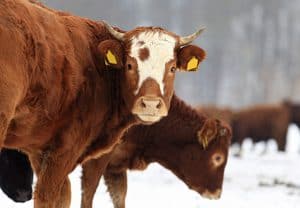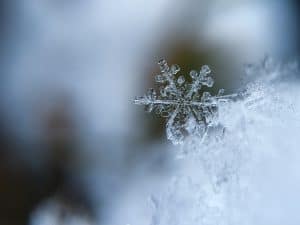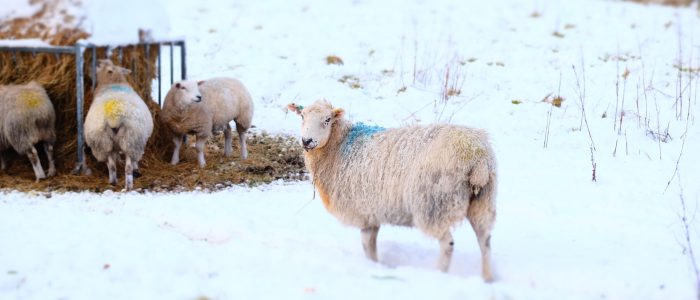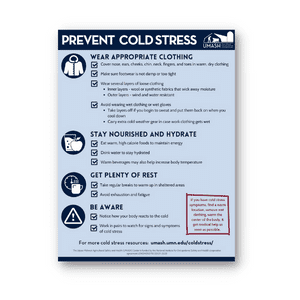UPDATED JULY 2023
 Upper Midwest winters are known for biting cold, chilling winds, ice, snow, and sleet. For those in agriculture, especially those working with livestock, the work doesn’t stop in the winter – making cold conditions not only a challenge but a serious hazard on the farm. While working through the winter chill may be tempting, cold, wet, and windy conditions can be dangerous, potentially leading to severe illnesses, injuries, or death.
Upper Midwest winters are known for biting cold, chilling winds, ice, snow, and sleet. For those in agriculture, especially those working with livestock, the work doesn’t stop in the winter – making cold conditions not only a challenge but a serious hazard on the farm. While working through the winter chill may be tempting, cold, wet, and windy conditions can be dangerous, potentially leading to severe illnesses, injuries, or death.
Cold stress occurs when the body loses heat and cannot warm itself. Four factors contribute to cold stress: cold temperatures, high or cold wind, dampness, and cold water. Exposure to cold and wet weather can cause life-threatening conditions like hypothermia, frostbite, trench foot, and chilblains (itching, red patches, swelling, and blistering on your hands and feet).
 Although we cannot stop the winter chill, we can practice safety to better protect ourselves. The proper precautions can help prevent and minimize the risk of cold stress among you and your workers.
Although we cannot stop the winter chill, we can practice safety to better protect ourselves. The proper precautions can help prevent and minimize the risk of cold stress among you and your workers.
That’s why UMASH has created a Cold Stress toolkit with resources to recognize signs and symptoms of cold stress so you can stay safe while working through the winter.
FEATURED RESOURCES
COLD STRESS TOOLKIT
- Cold Stress
NIOSH - What is Cold Stress?
University of Iowa Environmental Health and Safety - Preventing Cold-related Illness, Injury & Death among Workers
CDC - Cold Stress Facts
Princeton University: Office of Environmental Health and Safety - Cold Stress Guide
OSHA
- Types of Cold-related Illnesses
CDC - NIOSH Fast Facts: Protecting Yourself from Cold Stress
NIOSH - Hypothermia, Frostbite, and Trench Foot for Trainers and Supervisors
OSU Ag Safety - Prevent Hypothermia and Frostbite
CDC - Hypothermia and Cold Weather Injuries, Outdoor Action Guide
National Ag Safety Database - How to Identify and Treat Hypothermia and Frostbite
American Red Cross
- Working in Cold Weather
OSU Ag Safety - NIOSH Working in Cold Podcast
NIOSH - Staying Healthy in the Elements
Kansas AgriAbility - The Physiological Response of Working in Cold Environments and how your PPE can Help
NIOSH Science Blog - Colder Weather Tips for Midwestern Dairy Farm Employees
SDSU Extension - Working in Cold Weather: 4 Safety Tips for Farmers and Ranchers
Farm Bureau - Winter and Cold Weather Safety Tips on the Farm
American Family Insurance - Winter Weather: Plan.Equip.Train
OSHA - A Reminder from NIOSH: Stay Safe When Working Outdoors in Cold Weather
CDC - Winter Safety Tips for People with Disabilities
Easterseals - How to Find Winter Coats
Need Help Paying Bills
- Ice Safety
Minnesota Department of Natural Resources - Ice Safety
Wisconsin Department of Natural Resources - Preventing Falls on the Ice: Tips for Farmers
GPCAH - Preventing Slips and Falls During Icy Conditions
OSU Ag Safety - Ice Safety Tips for Outdoor Activities
OSU Ag Safety - How to Stay Safe on Frozen Lakes, Ponds
Farm and Dairy Family
- Farm Safety Check: Farm First Aid
UMASH - SPOTLIGHT: First on your Farm: Be Ready with First Aid
UMASH - Preparing for a Winter Storm
CDC - Stay Safe During & After a Winter Storm
CDC - National Weather Service Winter Weather Forecast
National Oceanic and Atmospheric Administration - How to Protect Yourself from Winter Weather – Multilingual Resources
Federal Emergency Management Agency
- Avoid, Spot, Treat Frostbite and Hypothermia Infographic and Poster
CDC - RECOMENDACIONES PARA IR A LA MONTAÑA, LA HIPOTERMIA
Camping el cares - Pocket-sized cards for employees: Protecting Workers from Cold Stress (English)
- Pocket-sized cards for employees: Protecting Workers from Cold Stress (Spanish)
OSHA - Chart for the workplace: When and how long to take breaks over a 4-hour shift given the temperature and wind speed
OSHA - Spanish Winter Infographics
National Weather Service - English Winter Infographics
National Weather Service - Winter Weather Safety Graphics
Federal Emergency Management Agency - Winter Weather Safety Social Media Toolkit
Federal Emergency Management Agency - Winter Social Media Toolkit
National Weather Service
- Managing Dairy Cattle in Cold Weather
UMN Extension - Prepare Livestock for Cold Weather
Iowa State University - Cold Stress and Beef Cattle
Penn State Extension
- Water Safety Demo: Hypothermia
Us Ag Centers - Agricultural Tailgate Safety Training: Cold Weather Exposure
National Ag Safety Database and OSU Extension



